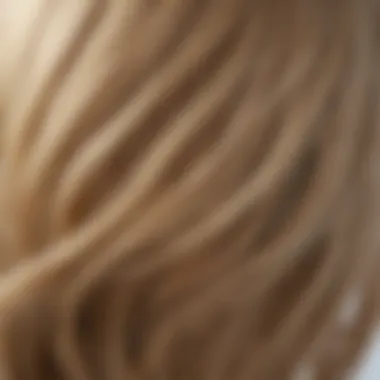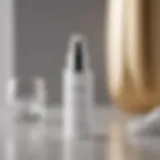Considering a Transition to Blonde: A Comprehensive Guide


Intro
Changing hair color is not just a simple decision; it's a journey that goes beyond mere aesthetics. Transitioning to blonde can rejuvenate your appearance but involves numerous factors to consider. This guide provides a thorough understanding of what to expect when contemplating such a significant change.
Why Choose Blonde?
The blonde spectrum varies from platinum to honey shades, offering versatility to suit different skin tones and personal styles. For many, this hue symbolizes youth and vibrancy. However, its implications stretch beyond aesthetics into maintenance and societal perceptions.
Essential Factors to Consider
Before embarking on this transformation, it is crucial to analyze several aspects:
- Suitability: Not every blonde shade is suitable for everyone. Assess your skin tone and eye color to find the most flattering option.
- Maintenance: Blonde hair often requires regular upkeep to prevent dullness and maintain vibrancy. Will you commit to frequent visits to the salon?
- Potential Damage: Bleaching can lead to hair damage if not done properly. Understand the risks and consider whether your hair is healthy enough for the change.
- Socio-Cultural Considerations: Blonde hair carries various associations. Awareness of these perceptions can create a more informed decision when you choose to transition.
Transitioning to blonde is more than just a trend; it's about understanding the implications on your personal style and grooming regimen. This guide aims to illuminate the path toward making a well-informed choice.
Understanding the Appeal of Blonde Hair
Blonde hair captures attention in a way few other hair colors do. Its allure extends beyond mere appearance, encompassing cultural significance and psychological effects. For many, transitioning to blonde is not just a style change; it is a statement that reflects personal identity and societal norms. This section explores the importance of understanding why blonde hair is appealing and the factors that contribute to this perception.
Cultural Significance
Throughout history, blonde hair has held various meanings across different cultures. In Western societies, it is often associated with beauty and desirability. Various media representations have further entrenched the belief that blonde hair is attractive. For example, Hollywood film stars with blonde locks have become icons, reinforcing this standard of beauty.
In other cultures, blonde hair can signify youth, purity, or even wealth. The perception can vary greatly depending on the region. For some, blonde signifies a sense of adventure or rebellion contrasting with traditional norms. It reflects a desire for change and an embrace of modernity. Understanding these cultural narratives can guide personal choices related to hair color and help in deciding if blonde hair aligns with one's identity and goals.
Psychological Impact
Changing hair color, particularly transitioning to blonde, can evoke significant psychological responses. Individuals often report feeling more confident or attractive after changing to a lighter shade. This might stem from the visual impact of blonde hair; it draws light and can create an impression of vitality and energy.
Moreover, this hair color change can symbolize a fresh start or new chapter in life. The act of going blonde may be motivated by personal transformation, such as career changes or improved self-image. Conversely, some may experience anxiety regarding public perceptions or fear of judgment from others. Understanding the psychological nuances at play can be crucial for anyone considering this change.
"The decision to go blonde is not merely aesthetic; it can represent deeper narratives of self-discovery and cultural identity."
In summary, the appeal of blonde hair is multifaceted. Culturally, it signifies glamour and desirability. Psychologically, the change can affect self-esteem and personal identity. These insights form a foundational understanding for anyone contemplating this significant hair transformation.
Assessing Personal Suitability for Blonde
When it comes to changing hair color to blonde, assessing personal suitability is a critical first step. Choosing a hair color that complements individual features can enhance one's appearance and boost confidence. There are several factors to consider to ensure that the decision aligns with personal style and aesthetic goals.
This section focuses on two essential elements: skin tone and natural hair color. Understanding these aspects can prevent dissatisfaction with the final look and help to achieve a harmonious and flattering result.
Skin Tone Considerations
Skin tone plays a significant role in how blonde hair will appear on an individual. Each person has a unique undertone, which can be categorized as warm, cool, or neutral. Selecting a blonde shade that matches the skin tone is crucial for achieving a balanced look.
- Warm Undertones: Individuals with warm undertones often have yellow or peachy hues in their skin. They generally look best with warmer blonde shades such as golden blonde or honey blonde. These colors can enhance the warmth of the skin and create a glowing effect.
- Cool Undertones: Those with cool undertones may have pink or blue tints in their skin. Ashy blondes or platinum shades tend to complement these undertones, offering a striking contrast and adding vibrancy.
- Neutral Undertones: If someone has a neutral undertone, they are versatile in their hair color choices. They can pull off both warm and cool blonde shades. A sandy blonde or beige blonde may work well for them, providing a balanced and natural appearance.
Knowing one's undertone can significantly affect the outcome of transitioning to blonde. A professional consultation can further assist in identifying the right shades that flatter the skin tone.
Natural Hair Color Analysis
Another key consideration is an individual's natural hair color. The existing base color can influence how blonde dye interacts with the hair and the ease of achieving the desired shade. Here are some guidelines:
- Dark Hair: Transitioning from dark hair to blonde requires a more extensive process, often involving bleaching. This can lead to significant damage, so it’s important to consider the care needed post-transition.
- Medium Hair: Those with medium brown hair may find it easier to achieve a lighter blonde with less pronounced bleaching. Shades like caramel or light golden blondes can be particularly flattering, offering depth without too much contrast.
- Light Hair: If an individual already has light brown or blonde hair, making a transition to a different shade of blonde will be simpler. Highlights or balayage techniques may serve as a good starting point, allowing for a gradual change that minimizes damage.
Understanding natural hair color and its compatibility with desired blonde shades can help ensure a smoother transition.


"Choosing the right shade of blonde is not just about following trends; it’s about personal expression and harmony with one’s natural features."
In essence, assessing personal suitability is a crucial part of the overall journey toward blonde hair. When individuals take the time to evaluate their skin tone and natural color, they are more likely to achieve a look that feels authentic and appealing.
Exploring Different Shades of Blonde
Understanding the various shades of blonde is crucial when considering a transition to this hair color. Each shade offers unique visual appeal and can complement different skin tones and personal styles. Selecting the right shade of blonde affects not only one’s appearance but also their overall confidence and self-expression. This section delves deeper into three popular shades, examining their characteristics and considerations.
Platinum Blonde
Platinum blonde is a striking choice that stands out. It is characterized by its almost white appearance, requiring significant lightening of the hair. This shade tends to suit individuals with cool undertones, enhancing their complexion remarkably.
However, achieving and maintaining platinum blonde hair comes with challenges. The lightening process can be harsh on hair, leading to dryness and breakage if not done properly. Using specialized shampoos and conditioners is essential for upkeep, along with regular treatments to help restore moisture.
Those opting for platinum blonde should consider their maintenance routine. Regular touch-ups are necessary to keep the shade vibrant, typically every four to six weeks. Additionally, it is advisable to consult with a professional colorist, especially for initial transitions, to minimize damage and achieve the desired result.
Golden Blonde
Golden blonde embodies warmth and radiance. This shade offers a sun-kissed look that is often favorable for individuals with warm or neutral skin tones. It provides a soft contrast, which can brighten the face while still maintaining a natural appearance.
One appealing aspect of golden blonde is versatility. Different techniques can be used to achieve this shade, such as highlights or all-over coloring. This approach allows for personalization since a blend of darker and lighter tones can create depth and dimension.
In terms of maintenance, golden blonde may be easier to sustain than lighter shades. While it may still require occasional touch-ups, fading tends to be less noticeable than in platinum shades. A good routine involves using color-protecting products and minimizing heat exposure to prevent dullness.
Ash Blonde
Ash blonde introduces cooler tones, often described as smoky or muted. This shade includes grayish or even greenish undertones, making it ideal for those with cooler skin tones. Ash blonde can bring a sophisticated edge to one’s style while also being less common than other shades.
The appeal of ash blonde lies in its ability to balance brightness with subtlety. Those who prefer a less conventional look may find ash blonde appealing. It provides a stylish contrast, often enhancing features while still retaining a sense of approachability.
However, achieving ash blonde does require careful consideration. The process of moving from warmer shades to ash can be complicated, often requiring a pre-lightening stage followed by a toning. This ensures that brassiness is reduced and the desired ashy effect is achieved.
Maintenance for ash blonde can be slightly more labor-intensive than warmer shades, given the propensity for brassiness to emerge over time. Using specific shampoos designed for blonde hair can greatly assist in keeping the color fresh.
The right shade of blonde can enhance personal style and boost confidence. Careful selection and maintenance will key to achieving a vibrant look.
The Process of Going Blonde
Transitioning to blonde hair is a significant decision that requires careful consideration. This process is not merely about changing color; it encapsulates various stages, each presenting its own challenges and opportunities. Understanding the steps involved allows individuals to make informed decisions, maximizing the benefits while minimizing potential downsides. A systematic approach ensures a more favorable outcome and provides a clear path towards the desired look.
Consultation with Professionals
A crucial first step in the transition to blonde is seeking the advice of hair professionals. A skilled stylist understands hair types, tones, and trends. They assess your current hair condition and discuss your goals. This personal consultation offers insights into what is achievable based on your unique characteristics.
During this meeting, share your expectations honestly. Discuss whether you desire a bold platinum hue or a softer golden tone. Professionals may recommend tests, such as a strand test, to preview how the color reacts with your natural hair. This step is essential in preventing disappointment later in the process.
Professionals can also guide you on timing. Factors such as schedule and hair health will influence the optimal timing for appointments, especially when multiple sessions may be necessary for desired results. Additionally, they can suggest the best products for at-home care post-coloring.
Step-by-Step Transition
Once the consultation phase is complete and a plan is in place, the actual process of going blonde can begin. Here, a systematic approach is beneficial to achieve the desired results gradually.
- Initial Lightening: If your natural color is dark, expect an initial session focused on lightening the hair. This can be a significant step, often requiring bleach or high-lift color. Patience is important, as dark shades need more than one session to safely transition to a lighter base.
- Toning Procedures: After the hair has reached the desired level of lightness, toning is often necessary. This process neutralizes unwanted brassy or orange tones, setting the perfect base for blonde shades. A stylist will choose a specific toner based on your hair's needs and your desired final color.
- Color Application: The actual blonde color is applied next, whether it is a full color or a highlights approach. Techniques like balayage allow for a soft, natural look, while full application can create a more uniform color. The choice depends on personal style and maintenance preference.
- Post-Color Care: After the coloring is complete, understanding post-care is critical. Products designed for colored hair should become part of your routine. These can help maintain color vibrancy and hair health.
- Follow-up Appointments: While the initial process is complete, follow-up sessions are vital for maintenance. Regular visits ensure that your blonde remains fresh, as roots grow in and products fade over time.
Remember, transitioning to blonde is a journey and not just a destination. It requires time, investment, and continual care.
Maintaining Blonde Hair
Maintaining blonde hair requires careful attention. The transition to blonde can be a significant commitment and entails specific upkeep procedures. This section outlines essential aspects for sustaining that vibrant, desired hue while avoiding common pitfalls.


Recommended Products
When it comes to maintaining blonde hair, product choice is vital. Not just any shampoo will do. Look for shampoos and conditioners specifically formulated for color-treated hair. For example, products containing purple pigments can minimize brassiness, a common issue associated with blonde hair. Some reputable brands include Pureology, Matrix, and TIGI Bed Head.
Using a sulfate-free cleanser is also beneficial. Sulfates can strip color, leading to fading and dullness. Consider investing in a good leave-in conditioner or a deep conditioning treatment as well. These products can help keep the strands hydrated and prevent dryness, which is a frequent concern with blonde hair.
In addition, using heat protectant sprays before styling is essential. Heat tools can exacerbate damage, so mitigating that risk with a protective product is wise. Regular overnight hair masks may also offer some healing benefits, as they help restore moisture.
Frequency of Maintenance Visits
The frequency of maintenance visits to the salon can depend on various factors such as the shade of blonde chosen, the natural hair color, and how quickly one's roots grow. On average, it is advised to visit every six to eight weeks for touch-ups. This reduces the visibility of roots and keeps the blonde looking fresh.
During these visits, professionals can assess the health of your hair and make necessary adjustments to your color, ensuring the upkeep aligns with your preferences. Over time, these appointments can become quite routine, allowing you to adapt your lifestyle to accommodate this maintenance. It is also beneficial to communicate openly with your stylist about the condition and needs of your hair throughout the process.
"Going blonde is just the beginning; maintenance is what keeps it looking its best."
In summary, maintaining blonde hair is not just about products but also a commitment to regular salon visits. Understanding and implementing these strategies ensures a successful blonde transformation, making your hair an asset rather than a chore.
Potential Damage and Solutions
Understanding the potential damage that comes with a transition to blonde hair is crucial. Lightening hair can lead to structural changes, which may weaken strands. This awareness allows individuals to make informed decisions and adopt preventative measures. Healthy hair is an essential aspect of personal grooming and style, thus understanding the risks and solutions can help maintain the desired look while minimizing damage.
Understanding Hair Damage Levels
When altering hair color, especially towards lighter shades like blonde, hair can sustain various levels of damage. Hair damage can often be categorized as follows:
- Chemical Damage: This occurs typically during the bleach process. Hair cuticles may lift, leading to porous and brittle hair.
- Mechanical Damage: Caused by harsh brushing or styling practices. This type of damage can exacerbate the effects of chemical processes.
- Heat Damage: Excessive use of heat styling tools like straighteners or curling irons can further weaken hair.
The severity of these damage levels varies with hair type. Individuals with fine hair often experience more significant damage compared to those with thick, coarse strands. Recognizing these damage types is essential for effective hair care.
"The transition to blonde requires commitment to maintaining hair health. Understanding damage levels is the first step."
Repair and Recovery Techniques
Once damage is assessed, taking corrective actions becomes critical. Several methods and practices can aid in repairing and restoring health to blonde hair:
- Deep Conditioning Treatments: Using masks that penetrate deeply can help restore moisture and nutrients.
- Regular Trims: Cutting off split ends prevents further breakage and helps maintain a healthier appearance.
- Protein Treatments: Essential for replenishing proteins lost during the bleaching process. These treatments help rebuild hair structure and strength.
- Avoiding Heat: Limiting the use of styling tools can greatly reduce additional damage. Whenever possible, embrace natural drying or heatless styling methods.
- Hydrating Products: Look for shampoos and conditioners rich in hydrating ingredients. These products help maintain moisture balance, crucial for dry blonde hair.
- Brands such as Olaplex and Moroccanoil offer products designed to strengthen and repair chemically treated hair.
Social Perceptions of Blonde Hair
Understanding social perceptions of blonde hair is crucial for anyone contemplating this significant change. Culture often influences how hair color can affect personal image and societal reception. Blonde hair can carry various connotations depending on the context and setting.
One primary aspect to consider is the stereotypes associated with blonde hair. These preconceived notions can be both positive and negative, shaping how individuals with blonde hair are perceived by those around them. Some people associate blonde hair with youthfulness, beauty, and vitality. This connection can encourage a sense of confidence in those who choose this color. However, these stereotypes can also lead to unrealistic expectations, wherein individuals may feel pressured to conform to a specific manner or personality type just because of their hair color. Awareness of these stereotypes is important to navigate social interactions.
Blonde Stereotypes
Blonde stereotypes have persisted throughout various cultures. Often depicted in media, blonde individuals are sometimes seen as carefree or less intelligent. Such associations can be damaging and may contribute to the generalization of individuals based solely on their hair color. For men, having blonde hair might invoke assumptions about their personality or style.
However, it is essential to recognize that stereotypes do not define an individual. A person's character and abilities extend far beyond physical appearance. Being aware of these stereotypes could help one manage expectations and build a more authentic presentation of oneself. Breaking the mold requires self-assuredness and a strategy for effectively communicating identity regardless of societal norms.
Evolving Trends in Hairstyles
As fashion continues to change, so do perceptions regarding hairstyles and colors. In recent years, there has been a noticeable shift in how society views blonde hair, driven by influencers and celebrities. No longer solely associated with traditional beauty standards, blonde hair has diversified into numerous styles and shades. This evolution has led to an increase in acceptance and experimentation with hair color.
Moreover, social media platforms like Instagram and TikTok have amplified diverse representations of blonde hairstyles. People showcase their unique styles, blending shades and techniques previously deemed unconventional. The growing embrace of individuality in hairstyles does not just apply to blonde hair but reflects broader societal trends toward inclusivity and self-expression.


Cost Considerations
When considering a transition to blonde hair, understanding the cost implications is crucial. The financial aspects can influence your decision, as well as your overall experience with the process. A blonde transformation typically involves initial expenses followed by ongoing maintenance costs. By being informed, you can make choices that align with your budget while still achieving the desired look.
Initial Transition Costs
The journey to blonde often begins with significant upfront costs. This is particularly true if you require professional assistance. Depending on the current state of your hair, a full color change may necessitate several salon visits.
Professional services, such as those offered at L'Oreal or Redken, may charge a premium for their expertise.
- Consultation Fees: Meeting with a colorist for an initial assessment can cost between $50 to $100. This will help you understand which shade of blonde suits your features.
- Bleaching: This process can be the most expensive. Expect to pay anywhere between $100 to $300, depending on the hair length and the desired level of blonde.
- Bond Builders: Products such as Olaplex might be recommended during bleaching to protect your hair. Expect an additional cost of about $40 to $100.
These initial costs can add up quickly, so planning your transition and budgeting accordingly is essential. An alternative is to explore at-home kits available from brands like Clairol or Schwarzkopf, which can lower the cost but may lack the nuanced expertise that professionals provide.
Long-term Financial Commitment
Transitioning to blonde hair doesn't stop with an initial visit to the salon. The long-term financial commitment is significant. Maintaining the integrity and freshness of your blonde look requires continuous investment, which can vary based on individual choices.
- Hair Maintenance: Regular salon visits will be necessary, with color touch-ups every 4 to 6 weeks. Each visit could range from $75 to $150, depending on your location and stylist expertise.
- Products: Specific shampoos and conditioners designed for blonde hair can be more expensive. Expect to budget at least $30 to $50 monthly for effective products that help maintain color and minimize brassiness.
- Treatment Costs: Regular treatments such as deep conditioning or glossing can add another $50 to $100 to your budget each month.
A commitment to experiencing blonde hair fully can lead to higher long-term expenses, so it is wise to strategize carefully before making this transformation.
In summary, the cost considerations of transitioning to blonde hair can be substantial. By understanding both initial and ongoing expenses, you can approach this hair color change not only as a style change but also as a serious financial investment. You may prioritize certain steps and products to ensure your financial commitment aligns with your goals, allowing you to enjoy your new look without unexpected financial strain.
Alternatives to Permanent Dye
Considering alternatives to permanent dye is essential for those contemplating a transition to blonde. Permanent hair dye can cause significant damage and resultant maintenance challenges. For individuals wary of fully committing to a drastic hair change, exploring less permanent options can provide flexibility and an opportunity to experiment safely.
Among the options available, temporary hair color offers a way to achieve a blonde look without locking into a choice that may be difficult to reverse. This can be particularly beneficial for individuals who want to test various shades or simply want blonde for a specific occasion, reducing the risk of potential regret.
Another popular technique is the use of highlights and balayage, which allows for a more natural and subtle approach. These treatments lighten only sections of the hair, providing dimension while maintaining some of the natural color. This method not only minimizes damage but also extends the longevity of a vibrant appearance with less frequent touch-ups.
In summary, considering alternatives to permanent dye enhances the experience of going blonde while promoting hair health, offering a suitable balance for those interested in style and practicality. The following sections will delve into specific methods of achieving blonde hair without resorting to permanent dye options.
Temporary Hair Color Options
Temporary hair color options include products that wash out completely within a few shampoos, making them ideal for short-term use. These products can come in various forms such as sprays, gels, or mousse. They allow individuals to explore shades of blonde without damaging the hair significantly. This temporary solution appeals to those who might be hesitant about a long-term commitment or those who wish to change their look frequently.
Some common features of these products are:
- Ease of application: Most temporary colors can be applied at home, requiring minimal effort.
- Variety: A wide range of shades allows users to experiment with gold, ash, or platinum tones.
- Low damage: Since these products don't penetrate the hair shaft, they are generally less damaging.
However, it's essential to consider that temporary colors might not provide the same level of vibrancy as permanent dyes. They are best used as a trial method before deciding on a more permanent solution.
Highlights and Balayage Techniques
Highlights and balayage techniques are effective strategies for transitioning to blonde without the commitment of permanent dye.
- Highlights: This technique involves lightening specific strands of hair, allowing for a more textured look. By lightening around the face, individuals can enhance their features while maintaining depth and richness in the rest of their hair.
- Balayage: Originating from a French word meaning "to sweep," balayage offers a soft grow-out effect. Colorists paint color onto the hair freehand, creating a natural gradient. This method is particularly favored for its low maintenance and understated aesthetic.
Both techniques are versatile and can work with various base hair colors. They allow individuals to adapt their blonde look to different seasons or trends without extensive upkeep.
"Choosing highlights or balayage allows for a seamless blend of colors, creating a dynamic look that evolves with your style, avoiding the stark contrast often seen with permanent dyes."
Closure
In this exploration of transitioning to blonde hair, we have delved into numerous aspects that merit careful consideration. As the article demonstrates, the allure of blonde hair is not merely aesthetic; it interweaves with cultural identity and psychological perspectives. Understanding the various shades of blonde available is critical for personal expression, and it enables individuals to choose a hue that resonates with their style.
The process of going blonde, from consultation to execution, reveals the importance of working with professionals. Their expertise is crucial in mitigating potential damage while achieving the desired look. Maintenance cannot be overlooked, as extending the vibrancy of blonde hair requires commitment and the right products. The financial considerations associated with the dyeing process and upkeep also play a significant role; true transformation can be both an emotional and monetary investment.
Moreover, beyond the visual changes, social perceptions surrounding blonde hair influence individual choices. Engaging with the stereotypes and evolving trends surrounding blonde hairstyles can aid in understanding how one's appearance impacts social interactions.
"Transitioning to blonde is not just a change in color, but a shift in how one portrays themselves to the world."
Reflecting on these elements, it is evident that the decision to go blonde is multifaceted and involves comprehensive deliberation. Individuals should weigh their motivations, personal style, and the implications of such a transition before taking the plunge. In summary, while the journey to blonde hair carries significant rewards, it also demands informed decision-making and a readiness for ongoing care.















